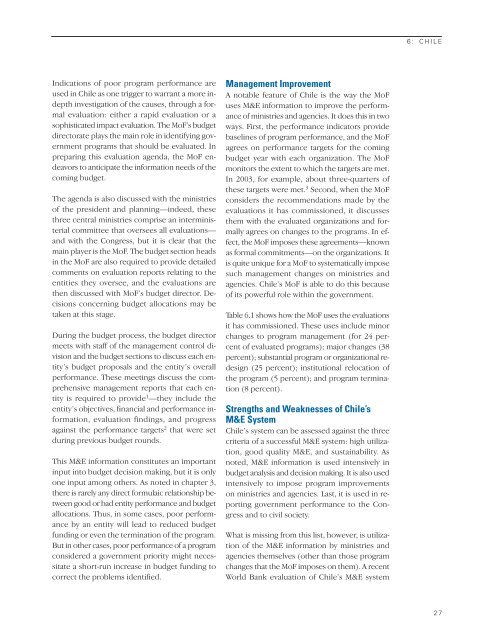How to Build M&E Systems to Support Better Government How to ...
How to Build M&E Systems to Support Better Government How to ...
How to Build M&E Systems to Support Better Government How to ...
Create successful ePaper yourself
Turn your PDF publications into a flip-book with our unique Google optimized e-Paper software.
6: CHILE<br />
Indications of poor program performance are<br />
used in Chile as one trigger <strong>to</strong> warrant a more indepth<br />
investigation of the causes, through a formal<br />
evaluation: either a rapid evaluation or a<br />
sophisticated impact evaluation. The MoF’s budget<br />
direc<strong>to</strong>rate plays the main role in identifying government<br />
programs that should be evaluated. In<br />
preparing this evaluation agenda, the MoF endeavors<br />
<strong>to</strong> anticipate the information needs of the<br />
coming budget.<br />
The agenda is also discussed with the ministries<br />
of the president and planning—indeed, these<br />
three central ministries comprise an interministerial<br />
committee that oversees all evaluations—<br />
and with the Congress, but it is clear that the<br />
main player is the MoF. The budget section heads<br />
in the MoF are also required <strong>to</strong> provide detailed<br />
comments on evaluation reports relating <strong>to</strong> the<br />
entities they oversee, and the evaluations are<br />
then discussed with MoF’s budget direc<strong>to</strong>r. Decisions<br />
concerning budget allocations may be<br />
taken at this stage.<br />
During the budget process, the budget direc<strong>to</strong>r<br />
meets with staff of the management control division<br />
and the budget sections <strong>to</strong> discuss each entity’s<br />
budget proposals and the entity’s overall<br />
performance. These meetings discuss the comprehensive<br />
management reports that each entity<br />
is required <strong>to</strong> provide 1 —they include the<br />
entity’s objectives, financial and performance information,<br />
evaluation findings, and progress<br />
against the performance targets 2 that were set<br />
during previous budget rounds.<br />
This M&E information constitutes an important<br />
input in<strong>to</strong> budget decision making, but it is only<br />
one input among others. As noted in chapter 3,<br />
there is rarely any direct formulaic relationship between<br />
good or bad entity performance and budget<br />
allocations. Thus, in some cases, poor performance<br />
by an entity will lead <strong>to</strong> reduced budget<br />
funding or even the termination of the program.<br />
But in other cases, poor performance of a program<br />
considered a government priority might necessitate<br />
a short-run increase in budget funding <strong>to</strong><br />
correct the problems identified.<br />
Management Improvement<br />
A notable feature of Chile is the way the MoF<br />
uses M&E information <strong>to</strong> improve the performance<br />
of ministries and agencies. It does this in two<br />
ways. First, the performance indica<strong>to</strong>rs provide<br />
baselines of program performance, and the MoF<br />
agrees on performance targets for the coming<br />
budget year with each organization. The MoF<br />
moni<strong>to</strong>rs the extent <strong>to</strong> which the targets are met.<br />
In 2003, for example, about three-quarters of<br />
these targets were met. 3 Second, when the MoF<br />
considers the recommendations made by the<br />
evaluations it has commissioned, it discusses<br />
them with the evaluated organizations and formally<br />
agrees on changes <strong>to</strong> the programs. In effect,<br />
the MoF imposes these agreements—known<br />
as formal commitments—on the organizations. It<br />
is quite unique for a MoF <strong>to</strong> systematically impose<br />
such management changes on ministries and<br />
agencies. Chile’s MoF is able <strong>to</strong> do this because<br />
of its powerful role within the government.<br />
Table 6.1 shows how the MoF uses the evaluations<br />
it has commissioned. These uses include minor<br />
changes <strong>to</strong> program management (for 24 percent<br />
of evaluated programs); major changes (38<br />
percent); substantial program or organizational redesign<br />
(25 percent); institutional relocation of<br />
the program (5 percent); and program termination<br />
(8 percent).<br />
Strengths and Weaknesses of Chile’s<br />
M&E System<br />
Chile’s system can be assessed against the three<br />
criteria of a successful M&E system: high utilization,<br />
good quality M&E, and sustainability. As<br />
noted, M&E information is used intensively in<br />
budget analysis and decision making. It is also used<br />
intensively <strong>to</strong> impose program improvements<br />
on ministries and agencies. Last, it is used in reporting<br />
government performance <strong>to</strong> the Congress<br />
and <strong>to</strong> civil society.<br />
What is missing from this list, however, is utilization<br />
of the M&E information by ministries and<br />
agencies themselves (other than those program<br />
changes that the MoF imposes on them). A recent<br />
World Bank evaluation of Chile’s M&E system<br />
27
















![[PDF] Community Development Toolkit - CommDev](https://img.yumpu.com/48616495/1/184x260/pdf-community-development-toolkit-commdev.jpg?quality=85)
